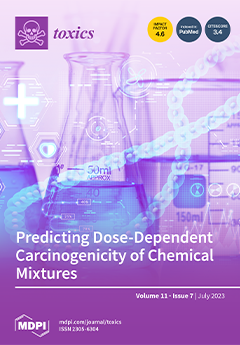The excretion of β
2-microglobulin (β
2M) above 300 µg/g creatinine, termed tubulopathy, was regarded as the critical effect of chronic exposure to the metal pollutant cadmium (Cd). However, current evidence suggests that Cd may induce nephron atrophy, resulting in a
[...] Read more.
The excretion of β
2-microglobulin (β
2M) above 300 µg/g creatinine, termed tubulopathy, was regarded as the critical effect of chronic exposure to the metal pollutant cadmium (Cd). However, current evidence suggests that Cd may induce nephron atrophy, resulting in a reduction in the estimated glomerular filtration rate (eGFR) below 60 mL/min/1.73 m
2. Herein, these pathologies were investigated in relation to Cd exposure, smoking, diabetes, and hypertension. The data were collected from 448 residents of Cd-polluted and non-polluted regions of Thailand. The body burden of Cd, indicated by the mean Cd excretion (E
Cd), normalized to creatinine clearance (C
cr) as (E
Cd/C
cr) × 100 in women and men did not differ (3.21 vs. 3.12 µg/L filtrate). After adjustment of the confounding factors, the prevalence odds ratio (POR) for tubulopathy and a reduced eGFR were increased by 1.9-fold and 3.2-fold for every 10-fold rise in the Cd body burden. In women only, a dose–effect relationship was seen between β
2M excretion (E
β2M/C
cr) and E
Cd/C
cr (
F = 3.431, η
2 0.021). In men, E
β2M/C
cr was associated with diabetes (β = 0.279). In both genders, the eGFR was inversely associated with E
β2M/C
cr. The respective covariate-adjusted mean eGFR values were 16.5 and 12.3 mL/min/1.73 m
2 lower in women and men who had severe tubulopathy ((E
β2M/C
cr) × 100 ≥ 1000 µg/L filtrate). These findings indicate that women were particularly susceptible to the nephrotoxicity of Cd, and that the increment of E
β2M/C
cr could be attributable mostly to Cd-induced impairment in the tubular reabsorption of the protein together with Cd-induced nephron loss, which is evident from an inverse relationship between E
β2M/C
cr and the eGFR.
Full article






